Business Environment Analysis: Bentley Motors Case Study Report
VerifiedAdded on 2020/12/29
|12
|4055
|93
Report
AI Summary
This report provides a comprehensive analysis of the business environment, using Bentley Motors as a case study. It begins with an introduction to the business environment, distinguishing between internal and external factors. The report then delves into cross-functional relations within an organization, using Bentley as an example, and explores the interplay between departments like production, sales, marketing, finance, and human resources. The core of the report focuses on the macro (external) environment, employing a PESTEL analysis to assess the political, economic, social, technological, environmental, and legal impacts on business operations, specifically within the automotive industry. Both positive and negative impacts are discussed, and the report further investigates the internal and external factors affecting Bentley Motors using SWOT analysis, identifying its strengths, weaknesses, opportunities, and threats. Finally, the report examines the interrelation of these strengths and weaknesses with external macro factors to provide a holistic view of Bentley's business environment.
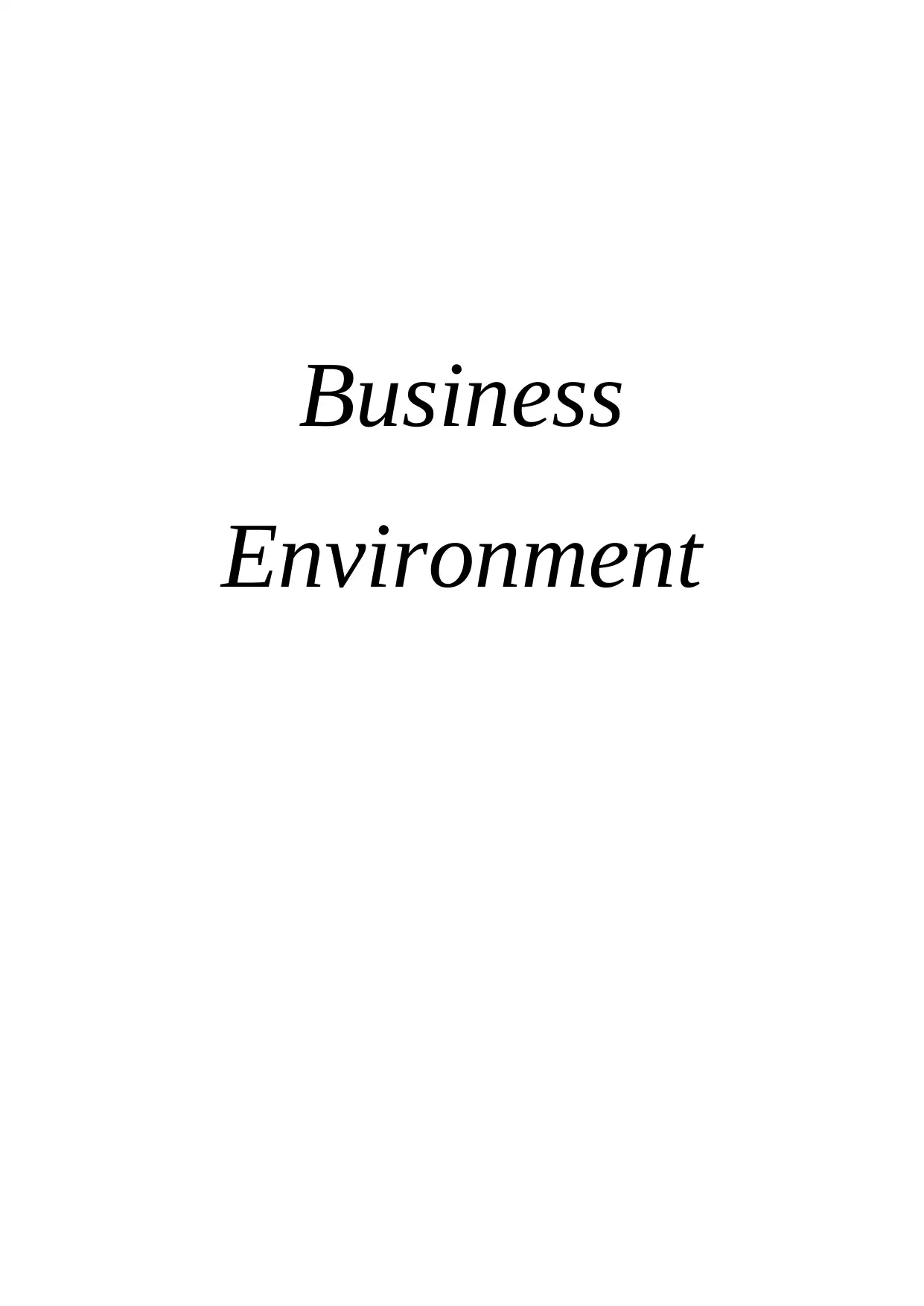
Business
Environment
Environment
Paraphrase This Document
Need a fresh take? Get an instant paraphrase of this document with our AI Paraphraser
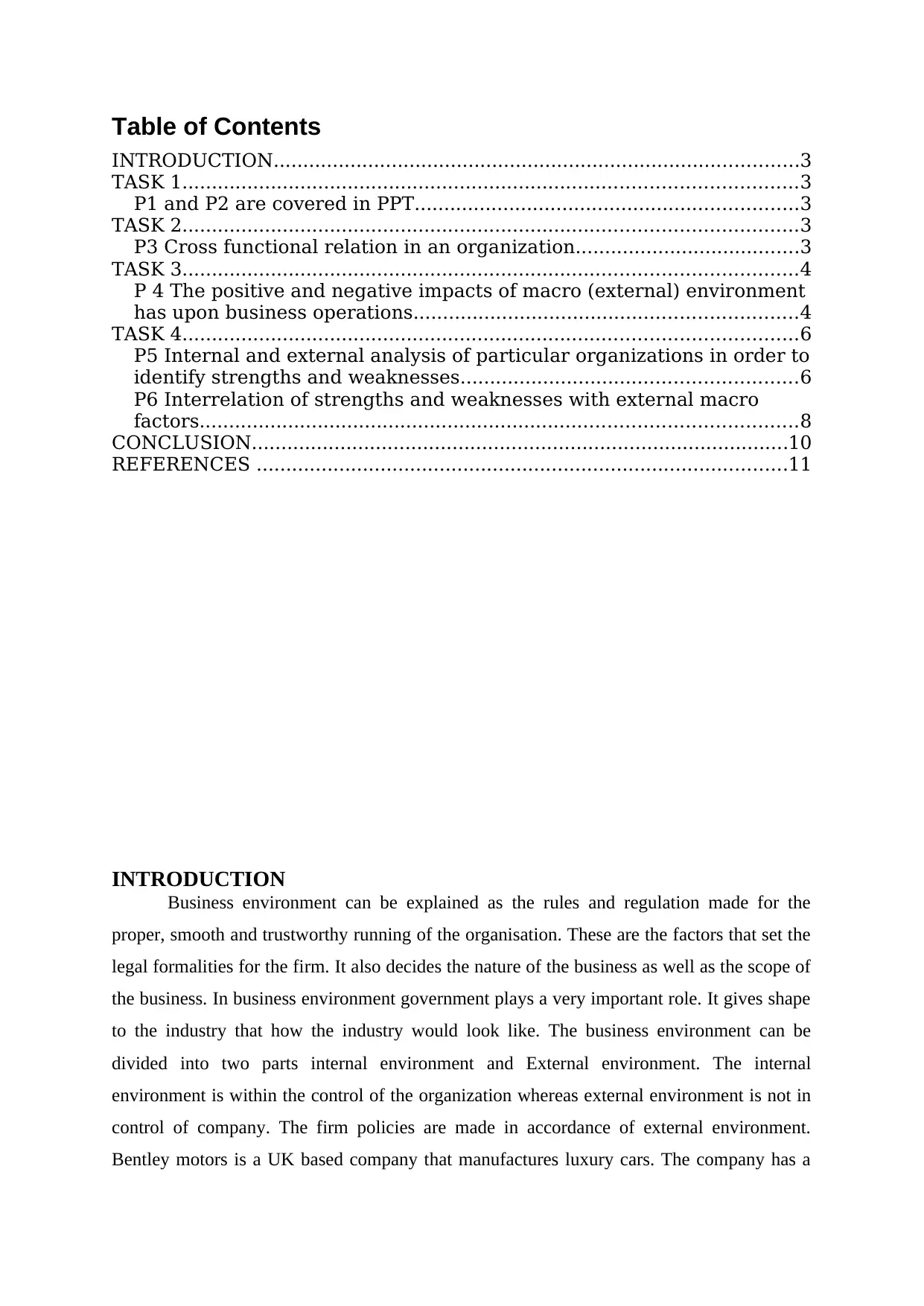
Table of Contents
INTRODUCTION.........................................................................................3
TASK 1........................................................................................................3
P1 and P2 are covered in PPT.................................................................3
TASK 2........................................................................................................3
P3 Cross functional relation in an organization......................................3
TASK 3........................................................................................................4
P 4 The positive and negative impacts of macro (external) environment
has upon business operations.................................................................4
TASK 4........................................................................................................6
P5 Internal and external analysis of particular organizations in order to
identify strengths and weaknesses.........................................................6
P6 Interrelation of strengths and weaknesses with external macro
factors.....................................................................................................8
CONCLUSION...........................................................................................10
REFERENCES ..........................................................................................11
INTRODUCTION
Business environment can be explained as the rules and regulation made for the
proper, smooth and trustworthy running of the organisation. These are the factors that set the
legal formalities for the firm. It also decides the nature of the business as well as the scope of
the business. In business environment government plays a very important role. It gives shape
to the industry that how the industry would look like. The business environment can be
divided into two parts internal environment and External environment. The internal
environment is within the control of the organization whereas external environment is not in
control of company. The firm policies are made in accordance of external environment.
Bentley motors is a UK based company that manufactures luxury cars. The company has a
INTRODUCTION.........................................................................................3
TASK 1........................................................................................................3
P1 and P2 are covered in PPT.................................................................3
TASK 2........................................................................................................3
P3 Cross functional relation in an organization......................................3
TASK 3........................................................................................................4
P 4 The positive and negative impacts of macro (external) environment
has upon business operations.................................................................4
TASK 4........................................................................................................6
P5 Internal and external analysis of particular organizations in order to
identify strengths and weaknesses.........................................................6
P6 Interrelation of strengths and weaknesses with external macro
factors.....................................................................................................8
CONCLUSION...........................................................................................10
REFERENCES ..........................................................................................11
INTRODUCTION
Business environment can be explained as the rules and regulation made for the
proper, smooth and trustworthy running of the organisation. These are the factors that set the
legal formalities for the firm. It also decides the nature of the business as well as the scope of
the business. In business environment government plays a very important role. It gives shape
to the industry that how the industry would look like. The business environment can be
divided into two parts internal environment and External environment. The internal
environment is within the control of the organization whereas external environment is not in
control of company. The firm policies are made in accordance of external environment.
Bentley motors is a UK based company that manufactures luxury cars. The company has a
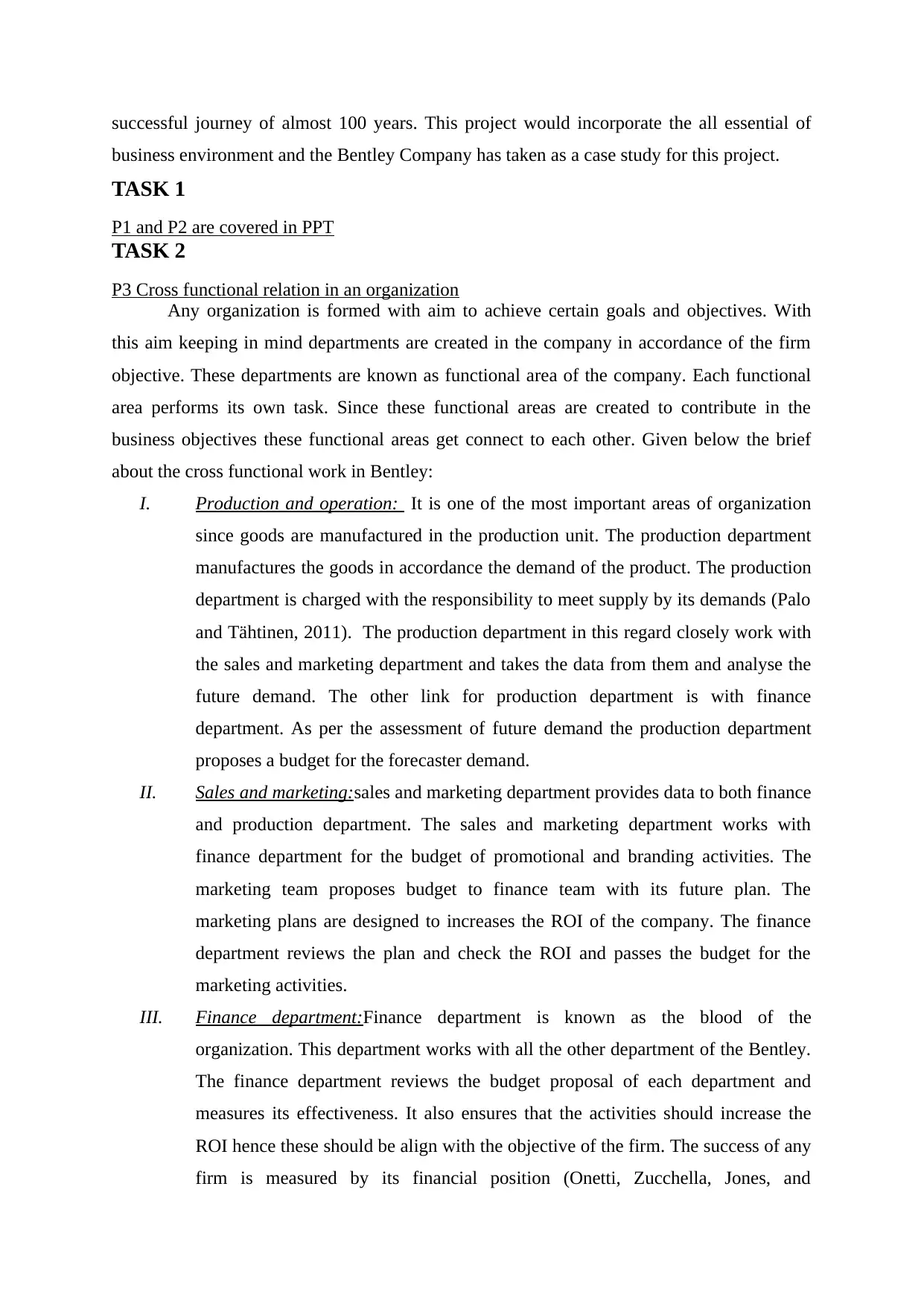
successful journey of almost 100 years. This project would incorporate the all essential of
business environment and the Bentley Company has taken as a case study for this project.
TASK 1
P1 and P2 are covered in PPT
TASK 2
P3 Cross functional relation in an organization
Any organization is formed with aim to achieve certain goals and objectives. With
this aim keeping in mind departments are created in the company in accordance of the firm
objective. These departments are known as functional area of the company. Each functional
area performs its own task. Since these functional areas are created to contribute in the
business objectives these functional areas get connect to each other. Given below the brief
about the cross functional work in Bentley:
I. Production and operation: It is one of the most important areas of organization
since goods are manufactured in the production unit. The production department
manufactures the goods in accordance the demand of the product. The production
department is charged with the responsibility to meet supply by its demands (Palo
and Tähtinen, 2011). The production department in this regard closely work with
the sales and marketing department and takes the data from them and analyse the
future demand. The other link for production department is with finance
department. As per the assessment of future demand the production department
proposes a budget for the forecaster demand.
II. Sales and marketing:sales and marketing department provides data to both finance
and production department. The sales and marketing department works with
finance department for the budget of promotional and branding activities. The
marketing team proposes budget to finance team with its future plan. The
marketing plans are designed to increases the ROI of the company. The finance
department reviews the plan and check the ROI and passes the budget for the
marketing activities.
III. Finance department:Finance department is known as the blood of the
organization. This department works with all the other department of the Bentley.
The finance department reviews the budget proposal of each department and
measures its effectiveness. It also ensures that the activities should increase the
ROI hence these should be align with the objective of the firm. The success of any
firm is measured by its financial position (Onetti, Zucchella, Jones, and
business environment and the Bentley Company has taken as a case study for this project.
TASK 1
P1 and P2 are covered in PPT
TASK 2
P3 Cross functional relation in an organization
Any organization is formed with aim to achieve certain goals and objectives. With
this aim keeping in mind departments are created in the company in accordance of the firm
objective. These departments are known as functional area of the company. Each functional
area performs its own task. Since these functional areas are created to contribute in the
business objectives these functional areas get connect to each other. Given below the brief
about the cross functional work in Bentley:
I. Production and operation: It is one of the most important areas of organization
since goods are manufactured in the production unit. The production department
manufactures the goods in accordance the demand of the product. The production
department is charged with the responsibility to meet supply by its demands (Palo
and Tähtinen, 2011). The production department in this regard closely work with
the sales and marketing department and takes the data from them and analyse the
future demand. The other link for production department is with finance
department. As per the assessment of future demand the production department
proposes a budget for the forecaster demand.
II. Sales and marketing:sales and marketing department provides data to both finance
and production department. The sales and marketing department works with
finance department for the budget of promotional and branding activities. The
marketing team proposes budget to finance team with its future plan. The
marketing plans are designed to increases the ROI of the company. The finance
department reviews the plan and check the ROI and passes the budget for the
marketing activities.
III. Finance department:Finance department is known as the blood of the
organization. This department works with all the other department of the Bentley.
The finance department reviews the budget proposal of each department and
measures its effectiveness. It also ensures that the activities should increase the
ROI hence these should be align with the objective of the firm. The success of any
firm is measured by its financial position (Onetti, Zucchella, Jones, and
⊘ This is a preview!⊘
Do you want full access?
Subscribe today to unlock all pages.

Trusted by 1+ million students worldwide
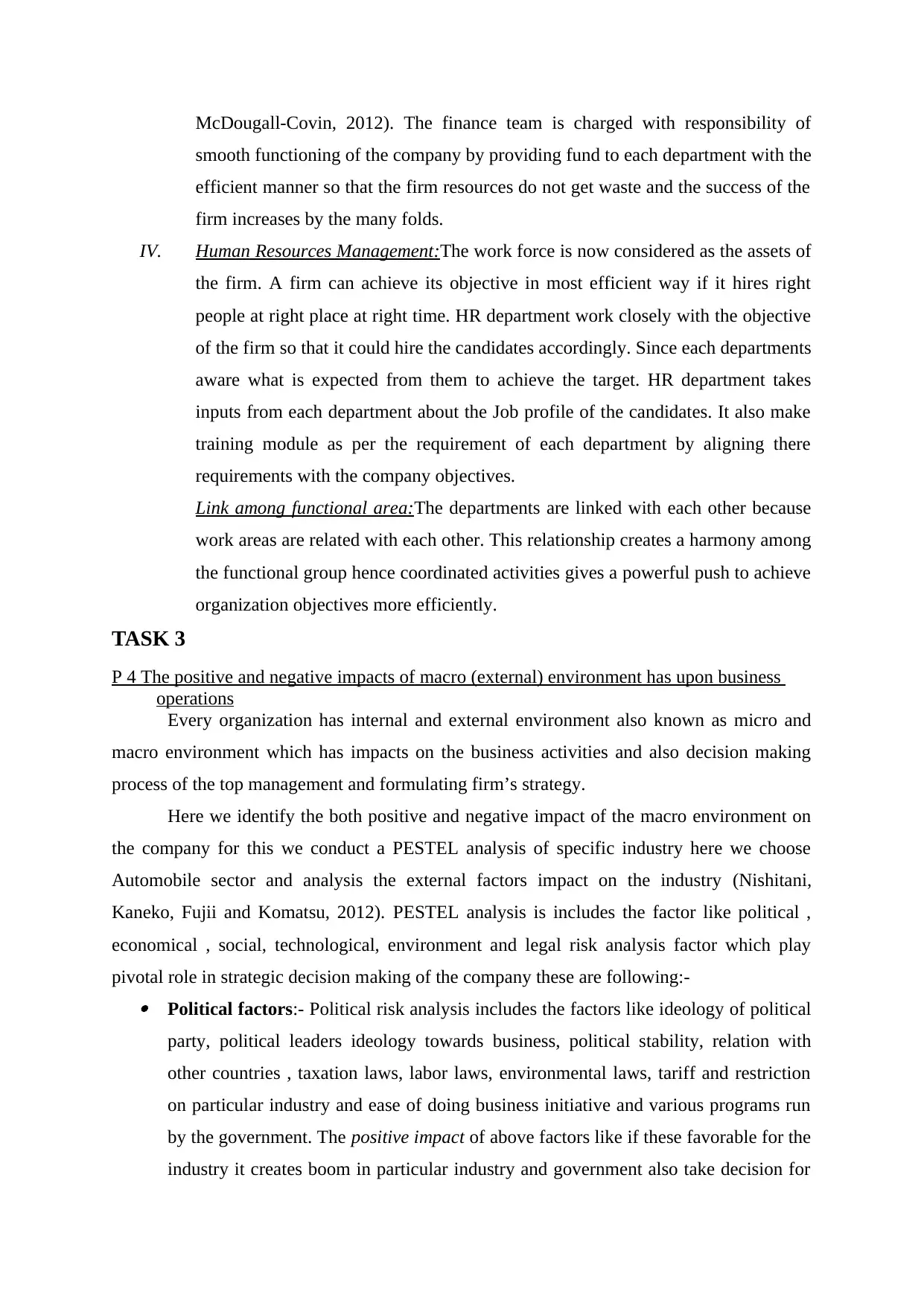
McDougall-Covin, 2012). The finance team is charged with responsibility of
smooth functioning of the company by providing fund to each department with the
efficient manner so that the firm resources do not get waste and the success of the
firm increases by the many folds.
IV. Human Resources Management:The work force is now considered as the assets of
the firm. A firm can achieve its objective in most efficient way if it hires right
people at right place at right time. HR department work closely with the objective
of the firm so that it could hire the candidates accordingly. Since each departments
aware what is expected from them to achieve the target. HR department takes
inputs from each department about the Job profile of the candidates. It also make
training module as per the requirement of each department by aligning there
requirements with the company objectives.
Link among functional area:The departments are linked with each other because
work areas are related with each other. This relationship creates a harmony among
the functional group hence coordinated activities gives a powerful push to achieve
organization objectives more efficiently.
TASK 3
P 4 The positive and negative impacts of macro (external) environment has upon business
operations
Every organization has internal and external environment also known as micro and
macro environment which has impacts on the business activities and also decision making
process of the top management and formulating firm’s strategy.
Here we identify the both positive and negative impact of the macro environment on
the company for this we conduct a PESTEL analysis of specific industry here we choose
Automobile sector and analysis the external factors impact on the industry (Nishitani,
Kaneko, Fujii and Komatsu, 2012). PESTEL analysis is includes the factor like political ,
economical , social, technological, environment and legal risk analysis factor which play
pivotal role in strategic decision making of the company these are following:- Political factors:- Political risk analysis includes the factors like ideology of political
party, political leaders ideology towards business, political stability, relation with
other countries , taxation laws, labor laws, environmental laws, tariff and restriction
on particular industry and ease of doing business initiative and various programs run
by the government. The positive impact of above factors like if these favorable for the
industry it creates boom in particular industry and government also take decision for
smooth functioning of the company by providing fund to each department with the
efficient manner so that the firm resources do not get waste and the success of the
firm increases by the many folds.
IV. Human Resources Management:The work force is now considered as the assets of
the firm. A firm can achieve its objective in most efficient way if it hires right
people at right place at right time. HR department work closely with the objective
of the firm so that it could hire the candidates accordingly. Since each departments
aware what is expected from them to achieve the target. HR department takes
inputs from each department about the Job profile of the candidates. It also make
training module as per the requirement of each department by aligning there
requirements with the company objectives.
Link among functional area:The departments are linked with each other because
work areas are related with each other. This relationship creates a harmony among
the functional group hence coordinated activities gives a powerful push to achieve
organization objectives more efficiently.
TASK 3
P 4 The positive and negative impacts of macro (external) environment has upon business
operations
Every organization has internal and external environment also known as micro and
macro environment which has impacts on the business activities and also decision making
process of the top management and formulating firm’s strategy.
Here we identify the both positive and negative impact of the macro environment on
the company for this we conduct a PESTEL analysis of specific industry here we choose
Automobile sector and analysis the external factors impact on the industry (Nishitani,
Kaneko, Fujii and Komatsu, 2012). PESTEL analysis is includes the factor like political ,
economical , social, technological, environment and legal risk analysis factor which play
pivotal role in strategic decision making of the company these are following:- Political factors:- Political risk analysis includes the factors like ideology of political
party, political leaders ideology towards business, political stability, relation with
other countries , taxation laws, labor laws, environmental laws, tariff and restriction
on particular industry and ease of doing business initiative and various programs run
by the government. The positive impact of above factors like if these favorable for the
industry it creates boom in particular industry and government also take decision for
Paraphrase This Document
Need a fresh take? Get an instant paraphrase of this document with our AI Paraphraser
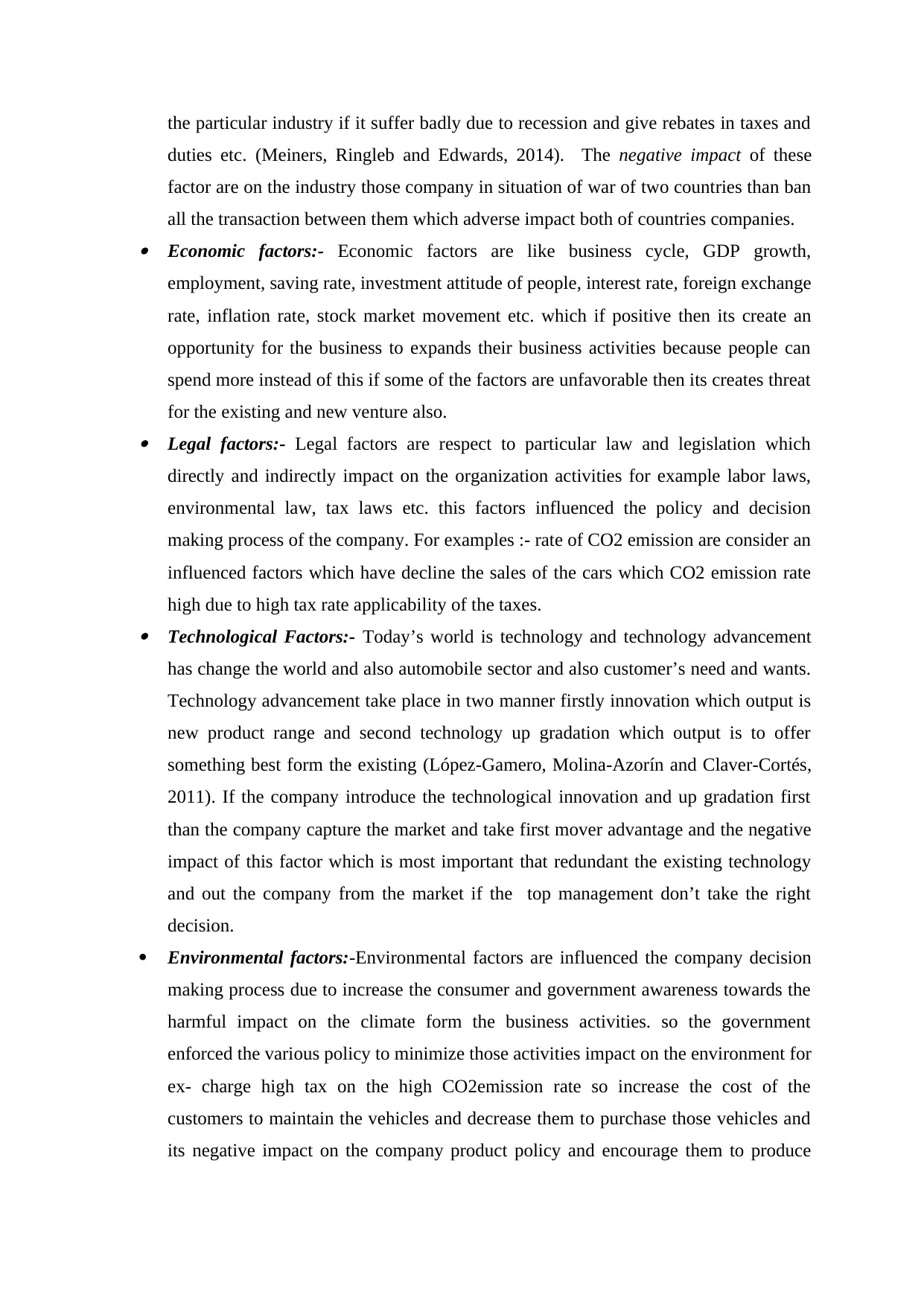
the particular industry if it suffer badly due to recession and give rebates in taxes and
duties etc. (Meiners, Ringleb and Edwards, 2014). The negative impact of these
factor are on the industry those company in situation of war of two countries than ban
all the transaction between them which adverse impact both of countries companies. Economic factors:- Economic factors are like business cycle, GDP growth,
employment, saving rate, investment attitude of people, interest rate, foreign exchange
rate, inflation rate, stock market movement etc. which if positive then its create an
opportunity for the business to expands their business activities because people can
spend more instead of this if some of the factors are unfavorable then its creates threat
for the existing and new venture also. Legal factors:- Legal factors are respect to particular law and legislation which
directly and indirectly impact on the organization activities for example labor laws,
environmental law, tax laws etc. this factors influenced the policy and decision
making process of the company. For examples :- rate of CO2 emission are consider an
influenced factors which have decline the sales of the cars which CO2 emission rate
high due to high tax rate applicability of the taxes. Technological Factors:- Today’s world is technology and technology advancement
has change the world and also automobile sector and also customer’s need and wants.
Technology advancement take place in two manner firstly innovation which output is
new product range and second technology up gradation which output is to offer
something best form the existing (López-Gamero, Molina-Azorín and Claver-Cortés,
2011). If the company introduce the technological innovation and up gradation first
than the company capture the market and take first mover advantage and the negative
impact of this factor which is most important that redundant the existing technology
and out the company from the market if the top management don’t take the right
decision.
Environmental factors:-Environmental factors are influenced the company decision
making process due to increase the consumer and government awareness towards the
harmful impact on the climate form the business activities. so the government
enforced the various policy to minimize those activities impact on the environment for
ex- charge high tax on the high CO2emission rate so increase the cost of the
customers to maintain the vehicles and decrease them to purchase those vehicles and
its negative impact on the company product policy and encourage them to produce
duties etc. (Meiners, Ringleb and Edwards, 2014). The negative impact of these
factor are on the industry those company in situation of war of two countries than ban
all the transaction between them which adverse impact both of countries companies. Economic factors:- Economic factors are like business cycle, GDP growth,
employment, saving rate, investment attitude of people, interest rate, foreign exchange
rate, inflation rate, stock market movement etc. which if positive then its create an
opportunity for the business to expands their business activities because people can
spend more instead of this if some of the factors are unfavorable then its creates threat
for the existing and new venture also. Legal factors:- Legal factors are respect to particular law and legislation which
directly and indirectly impact on the organization activities for example labor laws,
environmental law, tax laws etc. this factors influenced the policy and decision
making process of the company. For examples :- rate of CO2 emission are consider an
influenced factors which have decline the sales of the cars which CO2 emission rate
high due to high tax rate applicability of the taxes. Technological Factors:- Today’s world is technology and technology advancement
has change the world and also automobile sector and also customer’s need and wants.
Technology advancement take place in two manner firstly innovation which output is
new product range and second technology up gradation which output is to offer
something best form the existing (López-Gamero, Molina-Azorín and Claver-Cortés,
2011). If the company introduce the technological innovation and up gradation first
than the company capture the market and take first mover advantage and the negative
impact of this factor which is most important that redundant the existing technology
and out the company from the market if the top management don’t take the right
decision.
Environmental factors:-Environmental factors are influenced the company decision
making process due to increase the consumer and government awareness towards the
harmful impact on the climate form the business activities. so the government
enforced the various policy to minimize those activities impact on the environment for
ex- charge high tax on the high CO2emission rate so increase the cost of the
customers to maintain the vehicles and decrease them to purchase those vehicles and
its negative impact on the company product policy and encourage them to produce
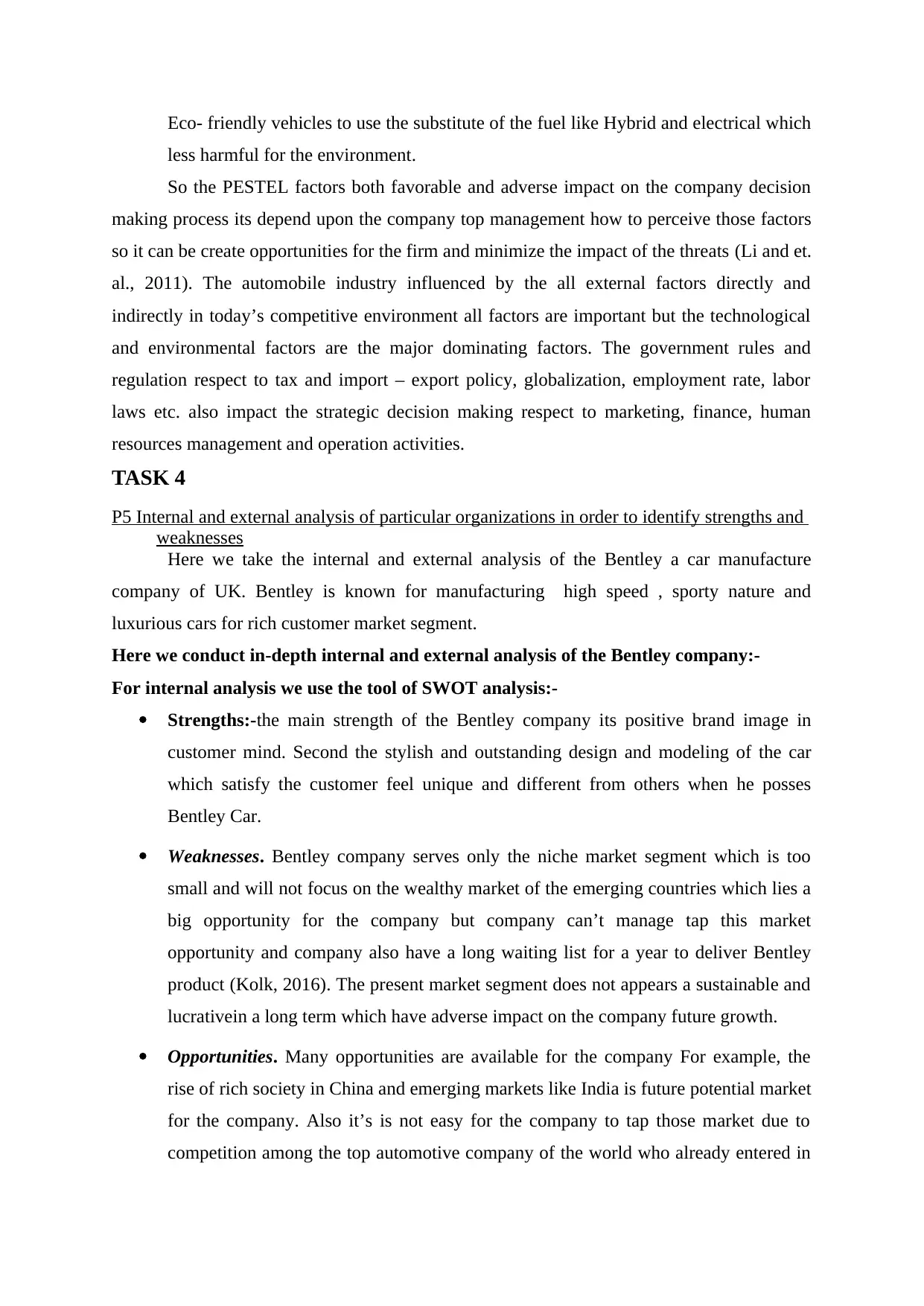
Eco- friendly vehicles to use the substitute of the fuel like Hybrid and electrical which
less harmful for the environment.
So the PESTEL factors both favorable and adverse impact on the company decision
making process its depend upon the company top management how to perceive those factors
so it can be create opportunities for the firm and minimize the impact of the threats (Li and et.
al., 2011). The automobile industry influenced by the all external factors directly and
indirectly in today’s competitive environment all factors are important but the technological
and environmental factors are the major dominating factors. The government rules and
regulation respect to tax and import – export policy, globalization, employment rate, labor
laws etc. also impact the strategic decision making respect to marketing, finance, human
resources management and operation activities.
TASK 4
P5 Internal and external analysis of particular organizations in order to identify strengths and
weaknesses
Here we take the internal and external analysis of the Bentley a car manufacture
company of UK. Bentley is known for manufacturing high speed , sporty nature and
luxurious cars for rich customer market segment.
Here we conduct in-depth internal and external analysis of the Bentley company:-
For internal analysis we use the tool of SWOT analysis:-
Strengths:-the main strength of the Bentley company its positive brand image in
customer mind. Second the stylish and outstanding design and modeling of the car
which satisfy the customer feel unique and different from others when he posses
Bentley Car.
Weaknesses. Bentley company serves only the niche market segment which is too
small and will not focus on the wealthy market of the emerging countries which lies a
big opportunity for the company but company can’t manage tap this market
opportunity and company also have a long waiting list for a year to deliver Bentley
product (Kolk, 2016). The present market segment does not appears a sustainable and
lucrativein a long term which have adverse impact on the company future growth.
Opportunities. Many opportunities are available for the company For example, the
rise of rich society in China and emerging markets like India is future potential market
for the company. Also it’s is not easy for the company to tap those market due to
competition among the top automotive company of the world who already entered in
less harmful for the environment.
So the PESTEL factors both favorable and adverse impact on the company decision
making process its depend upon the company top management how to perceive those factors
so it can be create opportunities for the firm and minimize the impact of the threats (Li and et.
al., 2011). The automobile industry influenced by the all external factors directly and
indirectly in today’s competitive environment all factors are important but the technological
and environmental factors are the major dominating factors. The government rules and
regulation respect to tax and import – export policy, globalization, employment rate, labor
laws etc. also impact the strategic decision making respect to marketing, finance, human
resources management and operation activities.
TASK 4
P5 Internal and external analysis of particular organizations in order to identify strengths and
weaknesses
Here we take the internal and external analysis of the Bentley a car manufacture
company of UK. Bentley is known for manufacturing high speed , sporty nature and
luxurious cars for rich customer market segment.
Here we conduct in-depth internal and external analysis of the Bentley company:-
For internal analysis we use the tool of SWOT analysis:-
Strengths:-the main strength of the Bentley company its positive brand image in
customer mind. Second the stylish and outstanding design and modeling of the car
which satisfy the customer feel unique and different from others when he posses
Bentley Car.
Weaknesses. Bentley company serves only the niche market segment which is too
small and will not focus on the wealthy market of the emerging countries which lies a
big opportunity for the company but company can’t manage tap this market
opportunity and company also have a long waiting list for a year to deliver Bentley
product (Kolk, 2016). The present market segment does not appears a sustainable and
lucrativein a long term which have adverse impact on the company future growth.
Opportunities. Many opportunities are available for the company For example, the
rise of rich society in China and emerging markets like India is future potential market
for the company. Also it’s is not easy for the company to tap those market due to
competition among the top automotive company of the world who already entered in
⊘ This is a preview!⊘
Do you want full access?
Subscribe today to unlock all pages.

Trusted by 1+ million students worldwide
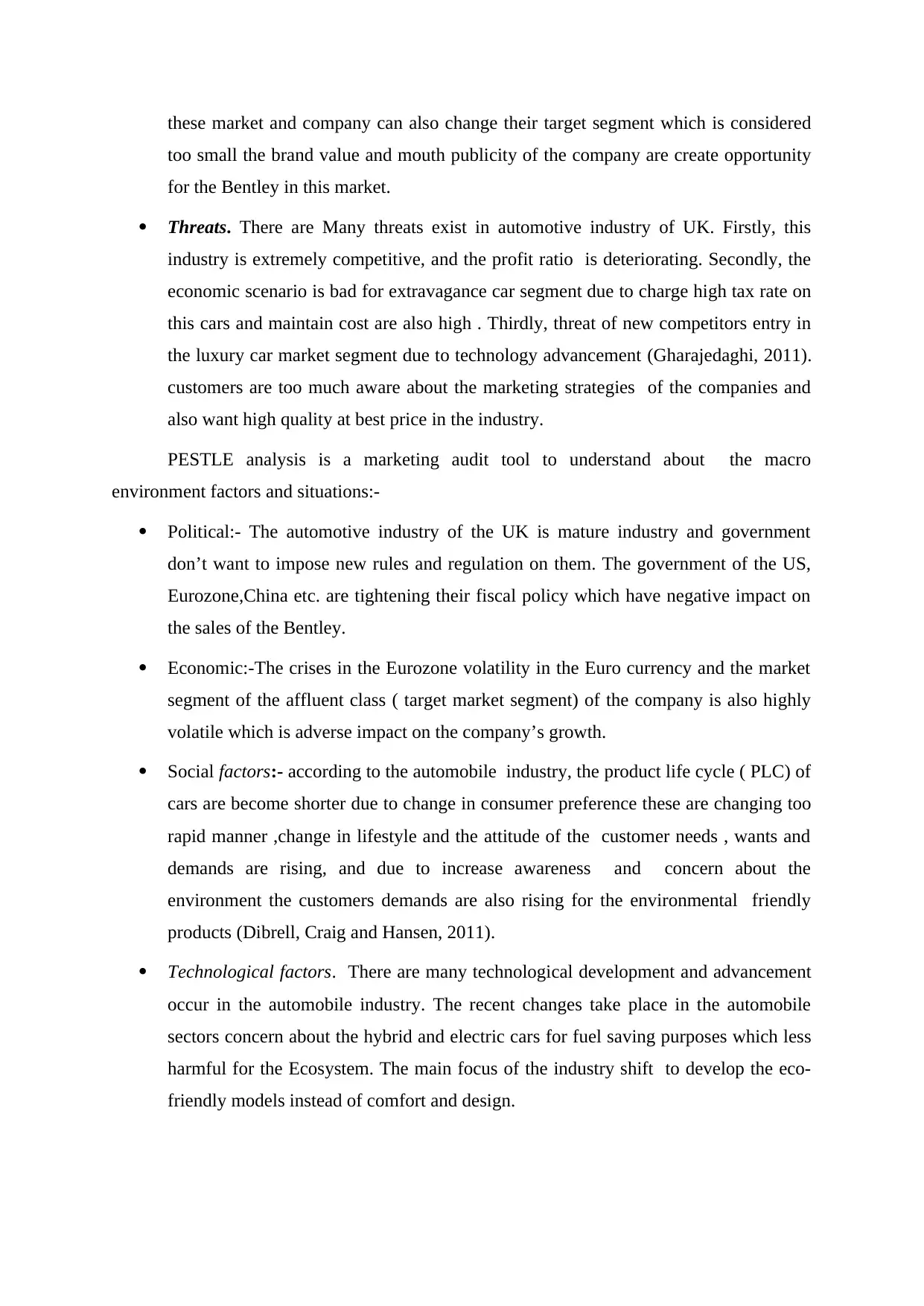
these market and company can also change their target segment which is considered
too small the brand value and mouth publicity of the company are create opportunity
for the Bentley in this market.
Threats. There are Many threats exist in automotive industry of UK. Firstly, this
industry is extremely competitive, and the profit ratio is deteriorating. Secondly, the
economic scenario is bad for extravagance car segment due to charge high tax rate on
this cars and maintain cost are also high . Thirdly, threat of new competitors entry in
the luxury car market segment due to technology advancement (Gharajedaghi, 2011).
customers are too much aware about the marketing strategies of the companies and
also want high quality at best price in the industry.
PESTLE analysis is a marketing audit tool to understand about the macro
environment factors and situations:-
Political:- The automotive industry of the UK is mature industry and government
don’t want to impose new rules and regulation on them. The government of the US,
Eurozone,China etc. are tightening their fiscal policy which have negative impact on
the sales of the Bentley.
Economic:-The crises in the Eurozone volatility in the Euro currency and the market
segment of the affluent class ( target market segment) of the company is also highly
volatile which is adverse impact on the company’s growth.
Social factors:- according to the automobile industry, the product life cycle ( PLC) of
cars are become shorter due to change in consumer preference these are changing too
rapid manner ,change in lifestyle and the attitude of the customer needs , wants and
demands are rising, and due to increase awareness and concern about the
environment the customers demands are also rising for the environmental friendly
products (Dibrell, Craig and Hansen, 2011).
Technological factors. There are many technological development and advancement
occur in the automobile industry. The recent changes take place in the automobile
sectors concern about the hybrid and electric cars for fuel saving purposes which less
harmful for the Ecosystem. The main focus of the industry shift to develop the eco-
friendly models instead of comfort and design.
too small the brand value and mouth publicity of the company are create opportunity
for the Bentley in this market.
Threats. There are Many threats exist in automotive industry of UK. Firstly, this
industry is extremely competitive, and the profit ratio is deteriorating. Secondly, the
economic scenario is bad for extravagance car segment due to charge high tax rate on
this cars and maintain cost are also high . Thirdly, threat of new competitors entry in
the luxury car market segment due to technology advancement (Gharajedaghi, 2011).
customers are too much aware about the marketing strategies of the companies and
also want high quality at best price in the industry.
PESTLE analysis is a marketing audit tool to understand about the macro
environment factors and situations:-
Political:- The automotive industry of the UK is mature industry and government
don’t want to impose new rules and regulation on them. The government of the US,
Eurozone,China etc. are tightening their fiscal policy which have negative impact on
the sales of the Bentley.
Economic:-The crises in the Eurozone volatility in the Euro currency and the market
segment of the affluent class ( target market segment) of the company is also highly
volatile which is adverse impact on the company’s growth.
Social factors:- according to the automobile industry, the product life cycle ( PLC) of
cars are become shorter due to change in consumer preference these are changing too
rapid manner ,change in lifestyle and the attitude of the customer needs , wants and
demands are rising, and due to increase awareness and concern about the
environment the customers demands are also rising for the environmental friendly
products (Dibrell, Craig and Hansen, 2011).
Technological factors. There are many technological development and advancement
occur in the automobile industry. The recent changes take place in the automobile
sectors concern about the hybrid and electric cars for fuel saving purposes which less
harmful for the Ecosystem. The main focus of the industry shift to develop the eco-
friendly models instead of comfort and design.
Paraphrase This Document
Need a fresh take? Get an instant paraphrase of this document with our AI Paraphraser
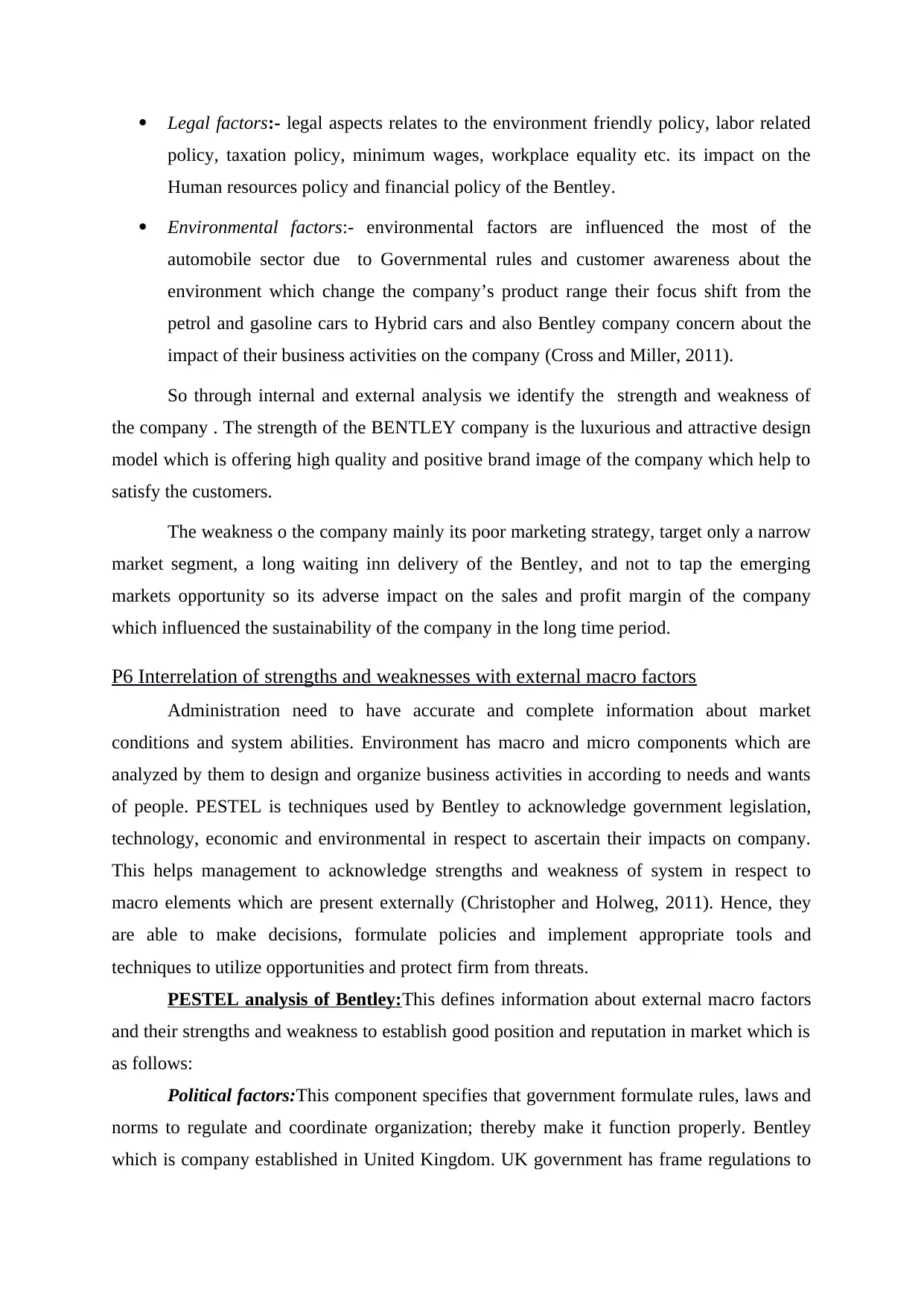
Legal factors:- legal aspects relates to the environment friendly policy, labor related
policy, taxation policy, minimum wages, workplace equality etc. its impact on the
Human resources policy and financial policy of the Bentley.
Environmental factors:- environmental factors are influenced the most of the
automobile sector due to Governmental rules and customer awareness about the
environment which change the company’s product range their focus shift from the
petrol and gasoline cars to Hybrid cars and also Bentley company concern about the
impact of their business activities on the company (Cross and Miller, 2011).
So through internal and external analysis we identify the strength and weakness of
the company . The strength of the BENTLEY company is the luxurious and attractive design
model which is offering high quality and positive brand image of the company which help to
satisfy the customers.
The weakness o the company mainly its poor marketing strategy, target only a narrow
market segment, a long waiting inn delivery of the Bentley, and not to tap the emerging
markets opportunity so its adverse impact on the sales and profit margin of the company
which influenced the sustainability of the company in the long time period.
P6 Interrelation of strengths and weaknesses with external macro factors
Administration need to have accurate and complete information about market
conditions and system abilities. Environment has macro and micro components which are
analyzed by them to design and organize business activities in according to needs and wants
of people. PESTEL is techniques used by Bentley to acknowledge government legislation,
technology, economic and environmental in respect to ascertain their impacts on company.
This helps management to acknowledge strengths and weakness of system in respect to
macro elements which are present externally (Christopher and Holweg, 2011). Hence, they
are able to make decisions, formulate policies and implement appropriate tools and
techniques to utilize opportunities and protect firm from threats.
PESTEL analysis of Bentley:This defines information about external macro factors
and their strengths and weakness to establish good position and reputation in market which is
as follows:
Political factors:This component specifies that government formulate rules, laws and
norms to regulate and coordinate organization; thereby make it function properly. Bentley
which is company established in United Kingdom. UK government has frame regulations to
policy, taxation policy, minimum wages, workplace equality etc. its impact on the
Human resources policy and financial policy of the Bentley.
Environmental factors:- environmental factors are influenced the most of the
automobile sector due to Governmental rules and customer awareness about the
environment which change the company’s product range their focus shift from the
petrol and gasoline cars to Hybrid cars and also Bentley company concern about the
impact of their business activities on the company (Cross and Miller, 2011).
So through internal and external analysis we identify the strength and weakness of
the company . The strength of the BENTLEY company is the luxurious and attractive design
model which is offering high quality and positive brand image of the company which help to
satisfy the customers.
The weakness o the company mainly its poor marketing strategy, target only a narrow
market segment, a long waiting inn delivery of the Bentley, and not to tap the emerging
markets opportunity so its adverse impact on the sales and profit margin of the company
which influenced the sustainability of the company in the long time period.
P6 Interrelation of strengths and weaknesses with external macro factors
Administration need to have accurate and complete information about market
conditions and system abilities. Environment has macro and micro components which are
analyzed by them to design and organize business activities in according to needs and wants
of people. PESTEL is techniques used by Bentley to acknowledge government legislation,
technology, economic and environmental in respect to ascertain their impacts on company.
This helps management to acknowledge strengths and weakness of system in respect to
macro elements which are present externally (Christopher and Holweg, 2011). Hence, they
are able to make decisions, formulate policies and implement appropriate tools and
techniques to utilize opportunities and protect firm from threats.
PESTEL analysis of Bentley:This defines information about external macro factors
and their strengths and weakness to establish good position and reputation in market which is
as follows:
Political factors:This component specifies that government formulate rules, laws and
norms to regulate and coordinate organization; thereby make it function properly. Bentley
which is company established in United Kingdom. UK government has frame regulations to
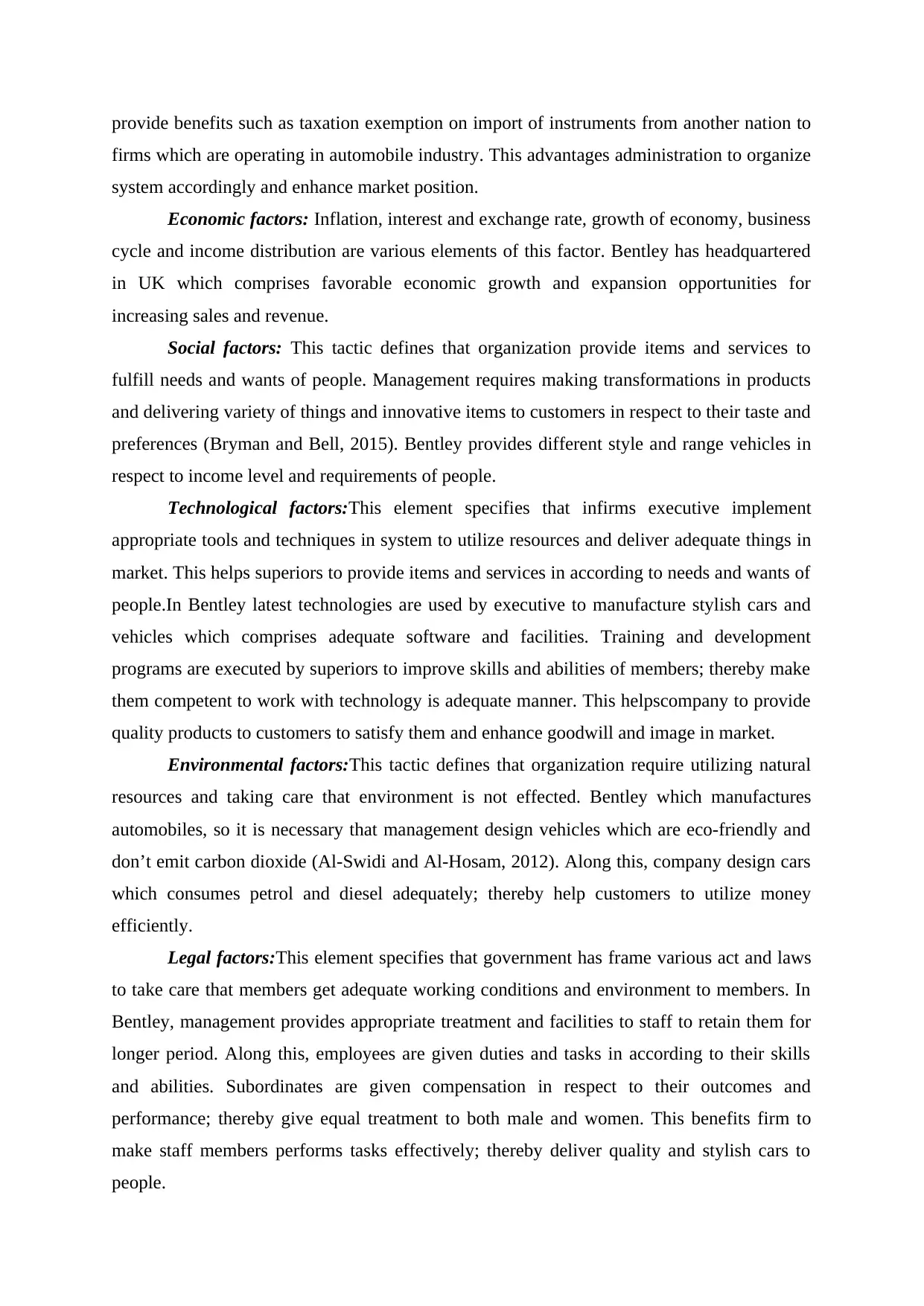
provide benefits such as taxation exemption on import of instruments from another nation to
firms which are operating in automobile industry. This advantages administration to organize
system accordingly and enhance market position.
Economic factors: Inflation, interest and exchange rate, growth of economy, business
cycle and income distribution are various elements of this factor. Bentley has headquartered
in UK which comprises favorable economic growth and expansion opportunities for
increasing sales and revenue.
Social factors: This tactic defines that organization provide items and services to
fulfill needs and wants of people. Management requires making transformations in products
and delivering variety of things and innovative items to customers in respect to their taste and
preferences (Bryman and Bell, 2015). Bentley provides different style and range vehicles in
respect to income level and requirements of people.
Technological factors:This element specifies that infirms executive implement
appropriate tools and techniques in system to utilize resources and deliver adequate things in
market. This helps superiors to provide items and services in according to needs and wants of
people.In Bentley latest technologies are used by executive to manufacture stylish cars and
vehicles which comprises adequate software and facilities. Training and development
programs are executed by superiors to improve skills and abilities of members; thereby make
them competent to work with technology is adequate manner. This helpscompany to provide
quality products to customers to satisfy them and enhance goodwill and image in market.
Environmental factors:This tactic defines that organization require utilizing natural
resources and taking care that environment is not effected. Bentley which manufactures
automobiles, so it is necessary that management design vehicles which are eco-friendly and
don’t emit carbon dioxide (Al-Swidi and Al-Hosam, 2012). Along this, company design cars
which consumes petrol and diesel adequately; thereby help customers to utilize money
efficiently.
Legal factors:This element specifies that government has frame various act and laws
to take care that members get adequate working conditions and environment to members. In
Bentley, management provides appropriate treatment and facilities to staff to retain them for
longer period. Along this, employees are given duties and tasks in according to their skills
and abilities. Subordinates are given compensation in respect to their outcomes and
performance; thereby give equal treatment to both male and women. This benefits firm to
make staff members performs tasks effectively; thereby deliver quality and stylish cars to
people.
firms which are operating in automobile industry. This advantages administration to organize
system accordingly and enhance market position.
Economic factors: Inflation, interest and exchange rate, growth of economy, business
cycle and income distribution are various elements of this factor. Bentley has headquartered
in UK which comprises favorable economic growth and expansion opportunities for
increasing sales and revenue.
Social factors: This tactic defines that organization provide items and services to
fulfill needs and wants of people. Management requires making transformations in products
and delivering variety of things and innovative items to customers in respect to their taste and
preferences (Bryman and Bell, 2015). Bentley provides different style and range vehicles in
respect to income level and requirements of people.
Technological factors:This element specifies that infirms executive implement
appropriate tools and techniques in system to utilize resources and deliver adequate things in
market. This helps superiors to provide items and services in according to needs and wants of
people.In Bentley latest technologies are used by executive to manufacture stylish cars and
vehicles which comprises adequate software and facilities. Training and development
programs are executed by superiors to improve skills and abilities of members; thereby make
them competent to work with technology is adequate manner. This helpscompany to provide
quality products to customers to satisfy them and enhance goodwill and image in market.
Environmental factors:This tactic defines that organization require utilizing natural
resources and taking care that environment is not effected. Bentley which manufactures
automobiles, so it is necessary that management design vehicles which are eco-friendly and
don’t emit carbon dioxide (Al-Swidi and Al-Hosam, 2012). Along this, company design cars
which consumes petrol and diesel adequately; thereby help customers to utilize money
efficiently.
Legal factors:This element specifies that government has frame various act and laws
to take care that members get adequate working conditions and environment to members. In
Bentley, management provides appropriate treatment and facilities to staff to retain them for
longer period. Along this, employees are given duties and tasks in according to their skills
and abilities. Subordinates are given compensation in respect to their outcomes and
performance; thereby give equal treatment to both male and women. This benefits firm to
make staff members performs tasks effectively; thereby deliver quality and stylish cars to
people.
⊘ This is a preview!⊘
Do you want full access?
Subscribe today to unlock all pages.

Trusted by 1+ million students worldwide
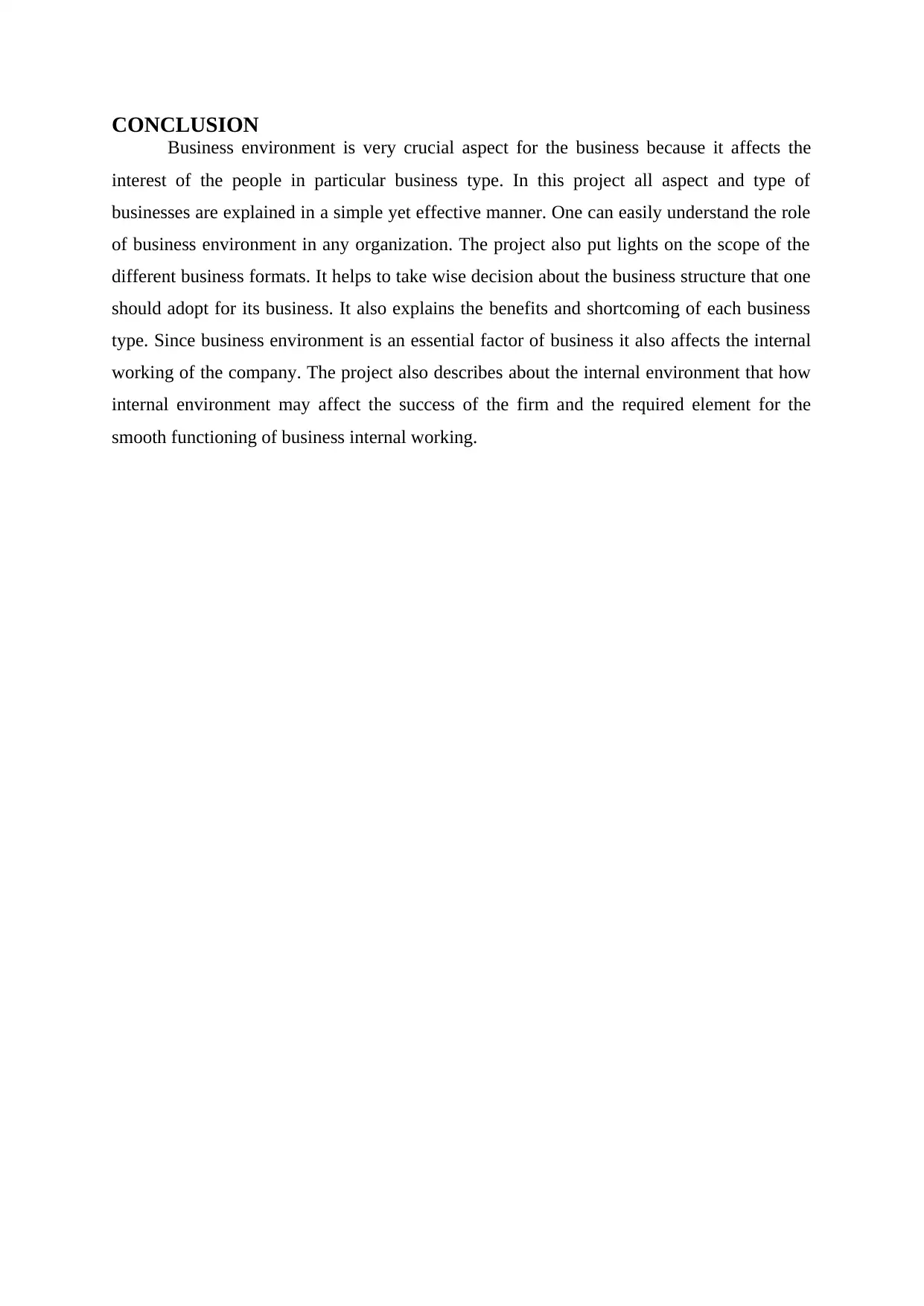
CONCLUSION
Business environment is very crucial aspect for the business because it affects the
interest of the people in particular business type. In this project all aspect and type of
businesses are explained in a simple yet effective manner. One can easily understand the role
of business environment in any organization. The project also put lights on the scope of the
different business formats. It helps to take wise decision about the business structure that one
should adopt for its business. It also explains the benefits and shortcoming of each business
type. Since business environment is an essential factor of business it also affects the internal
working of the company. The project also describes about the internal environment that how
internal environment may affect the success of the firm and the required element for the
smooth functioning of business internal working.
Business environment is very crucial aspect for the business because it affects the
interest of the people in particular business type. In this project all aspect and type of
businesses are explained in a simple yet effective manner. One can easily understand the role
of business environment in any organization. The project also put lights on the scope of the
different business formats. It helps to take wise decision about the business structure that one
should adopt for its business. It also explains the benefits and shortcoming of each business
type. Since business environment is an essential factor of business it also affects the internal
working of the company. The project also describes about the internal environment that how
internal environment may affect the success of the firm and the required element for the
smooth functioning of business internal working.
Paraphrase This Document
Need a fresh take? Get an instant paraphrase of this document with our AI Paraphraser
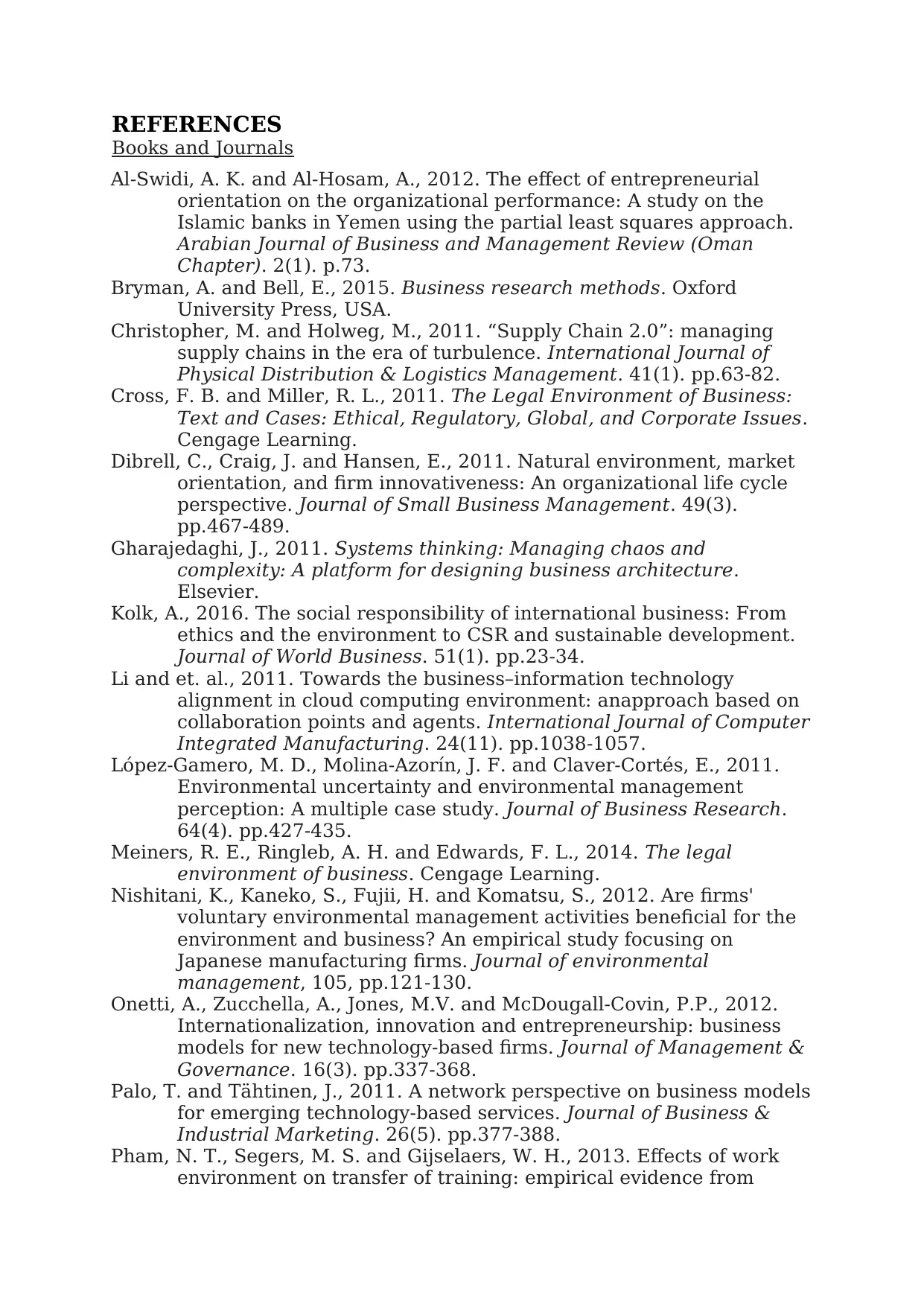
REFERENCES
Books and Journals
Al-Swidi, A. K. and Al-Hosam, A., 2012. The effect of entrepreneurial
orientation on the organizational performance: A study on the
Islamic banks in Yemen using the partial least squares approach.
Arabian Journal of Business and Management Review (Oman
Chapter). 2(1). p.73.
Bryman, A. and Bell, E., 2015. Business research methods. Oxford
University Press, USA.
Christopher, M. and Holweg, M., 2011. “Supply Chain 2.0”: managing
supply chains in the era of turbulence. International Journal of
Physical Distribution & Logistics Management. 41(1). pp.63-82.
Cross, F. B. and Miller, R. L., 2011. The Legal Environment of Business:
Text and Cases: Ethical, Regulatory, Global, and Corporate Issues.
Cengage Learning.
Dibrell, C., Craig, J. and Hansen, E., 2011. Natural environment, market
orientation, and firm innovativeness: An organizational life cycle
perspective. Journal of Small Business Management. 49(3).
pp.467-489.
Gharajedaghi, J., 2011. Systems thinking: Managing chaos and
complexity: A platform for designing business architecture.
Elsevier.
Kolk, A., 2016. The social responsibility of international business: From
ethics and the environment to CSR and sustainable development.
Journal of World Business. 51(1). pp.23-34.
Li and et. al., 2011. Towards the business–information technology
alignment in cloud computing environment: anapproach based on
collaboration points and agents. International Journal of Computer
Integrated Manufacturing. 24(11). pp.1038-1057.
López-Gamero, M. D., Molina-Azorín, J. F. and Claver-Cortés, E., 2011.
Environmental uncertainty and environmental management
perception: A multiple case study. Journal of Business Research.
64(4). pp.427-435.
Meiners, R. E., Ringleb, A. H. and Edwards, F. L., 2014. The legal
environment of business. Cengage Learning.
Nishitani, K., Kaneko, S., Fujii, H. and Komatsu, S., 2012. Are firms'
voluntary environmental management activities beneficial for the
environment and business? An empirical study focusing on
Japanese manufacturing firms. Journal of environmental
management, 105, pp.121-130.
Onetti, A., Zucchella, A., Jones, M.V. and McDougall-Covin, P.P., 2012.
Internationalization, innovation and entrepreneurship: business
models for new technology-based firms. Journal of Management &
Governance. 16(3). pp.337-368.
Palo, T. and Tähtinen, J., 2011. A network perspective on business models
for emerging technology-based services. Journal of Business &
Industrial Marketing. 26(5). pp.377-388.
Pham, N. T., Segers, M. S. and Gijselaers, W. H., 2013. Effects of work
environment on transfer of training: empirical evidence from
Books and Journals
Al-Swidi, A. K. and Al-Hosam, A., 2012. The effect of entrepreneurial
orientation on the organizational performance: A study on the
Islamic banks in Yemen using the partial least squares approach.
Arabian Journal of Business and Management Review (Oman
Chapter). 2(1). p.73.
Bryman, A. and Bell, E., 2015. Business research methods. Oxford
University Press, USA.
Christopher, M. and Holweg, M., 2011. “Supply Chain 2.0”: managing
supply chains in the era of turbulence. International Journal of
Physical Distribution & Logistics Management. 41(1). pp.63-82.
Cross, F. B. and Miller, R. L., 2011. The Legal Environment of Business:
Text and Cases: Ethical, Regulatory, Global, and Corporate Issues.
Cengage Learning.
Dibrell, C., Craig, J. and Hansen, E., 2011. Natural environment, market
orientation, and firm innovativeness: An organizational life cycle
perspective. Journal of Small Business Management. 49(3).
pp.467-489.
Gharajedaghi, J., 2011. Systems thinking: Managing chaos and
complexity: A platform for designing business architecture.
Elsevier.
Kolk, A., 2016. The social responsibility of international business: From
ethics and the environment to CSR and sustainable development.
Journal of World Business. 51(1). pp.23-34.
Li and et. al., 2011. Towards the business–information technology
alignment in cloud computing environment: anapproach based on
collaboration points and agents. International Journal of Computer
Integrated Manufacturing. 24(11). pp.1038-1057.
López-Gamero, M. D., Molina-Azorín, J. F. and Claver-Cortés, E., 2011.
Environmental uncertainty and environmental management
perception: A multiple case study. Journal of Business Research.
64(4). pp.427-435.
Meiners, R. E., Ringleb, A. H. and Edwards, F. L., 2014. The legal
environment of business. Cengage Learning.
Nishitani, K., Kaneko, S., Fujii, H. and Komatsu, S., 2012. Are firms'
voluntary environmental management activities beneficial for the
environment and business? An empirical study focusing on
Japanese manufacturing firms. Journal of environmental
management, 105, pp.121-130.
Onetti, A., Zucchella, A., Jones, M.V. and McDougall-Covin, P.P., 2012.
Internationalization, innovation and entrepreneurship: business
models for new technology-based firms. Journal of Management &
Governance. 16(3). pp.337-368.
Palo, T. and Tähtinen, J., 2011. A network perspective on business models
for emerging technology-based services. Journal of Business &
Industrial Marketing. 26(5). pp.377-388.
Pham, N. T., Segers, M. S. and Gijselaers, W. H., 2013. Effects of work
environment on transfer of training: empirical evidence from
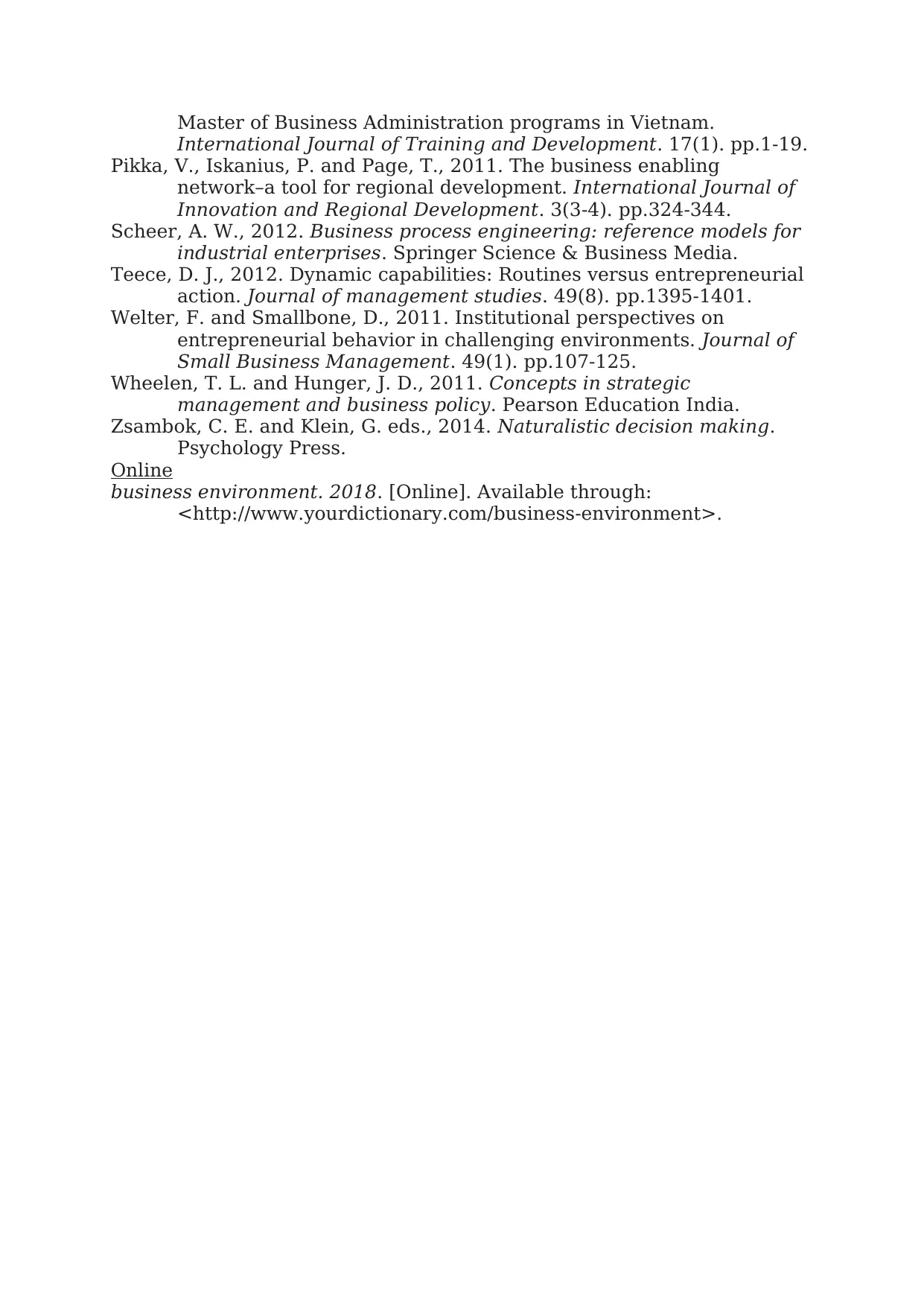
Master of Business Administration programs in Vietnam.
International Journal of Training and Development. 17(1). pp.1-19.
Pikka, V., Iskanius, P. and Page, T., 2011. The business enabling
network–a tool for regional development. International Journal of
Innovation and Regional Development. 3(3-4). pp.324-344.
Scheer, A. W., 2012. Business process engineering: reference models for
industrial enterprises. Springer Science & Business Media.
Teece, D. J., 2012. Dynamic capabilities: Routines versus entrepreneurial
action. Journal of management studies. 49(8). pp.1395-1401.
Welter, F. and Smallbone, D., 2011. Institutional perspectives on
entrepreneurial behavior in challenging environments. Journal of
Small Business Management. 49(1). pp.107-125.
Wheelen, T. L. and Hunger, J. D., 2011. Concepts in strategic
management and business policy. Pearson Education India.
Zsambok, C. E. and Klein, G. eds., 2014. Naturalistic decision making.
Psychology Press.
Online
business environment. 2018. [Online]. Available through:
<http://www.yourdictionary.com/business-environment>.
International Journal of Training and Development. 17(1). pp.1-19.
Pikka, V., Iskanius, P. and Page, T., 2011. The business enabling
network–a tool for regional development. International Journal of
Innovation and Regional Development. 3(3-4). pp.324-344.
Scheer, A. W., 2012. Business process engineering: reference models for
industrial enterprises. Springer Science & Business Media.
Teece, D. J., 2012. Dynamic capabilities: Routines versus entrepreneurial
action. Journal of management studies. 49(8). pp.1395-1401.
Welter, F. and Smallbone, D., 2011. Institutional perspectives on
entrepreneurial behavior in challenging environments. Journal of
Small Business Management. 49(1). pp.107-125.
Wheelen, T. L. and Hunger, J. D., 2011. Concepts in strategic
management and business policy. Pearson Education India.
Zsambok, C. E. and Klein, G. eds., 2014. Naturalistic decision making.
Psychology Press.
Online
business environment. 2018. [Online]. Available through:
<http://www.yourdictionary.com/business-environment>.
⊘ This is a preview!⊘
Do you want full access?
Subscribe today to unlock all pages.

Trusted by 1+ million students worldwide
1 out of 12
Related Documents
Your All-in-One AI-Powered Toolkit for Academic Success.
+13062052269
info@desklib.com
Available 24*7 on WhatsApp / Email
![[object Object]](/_next/static/media/star-bottom.7253800d.svg)
Unlock your academic potential
Copyright © 2020–2025 A2Z Services. All Rights Reserved. Developed and managed by ZUCOL.





